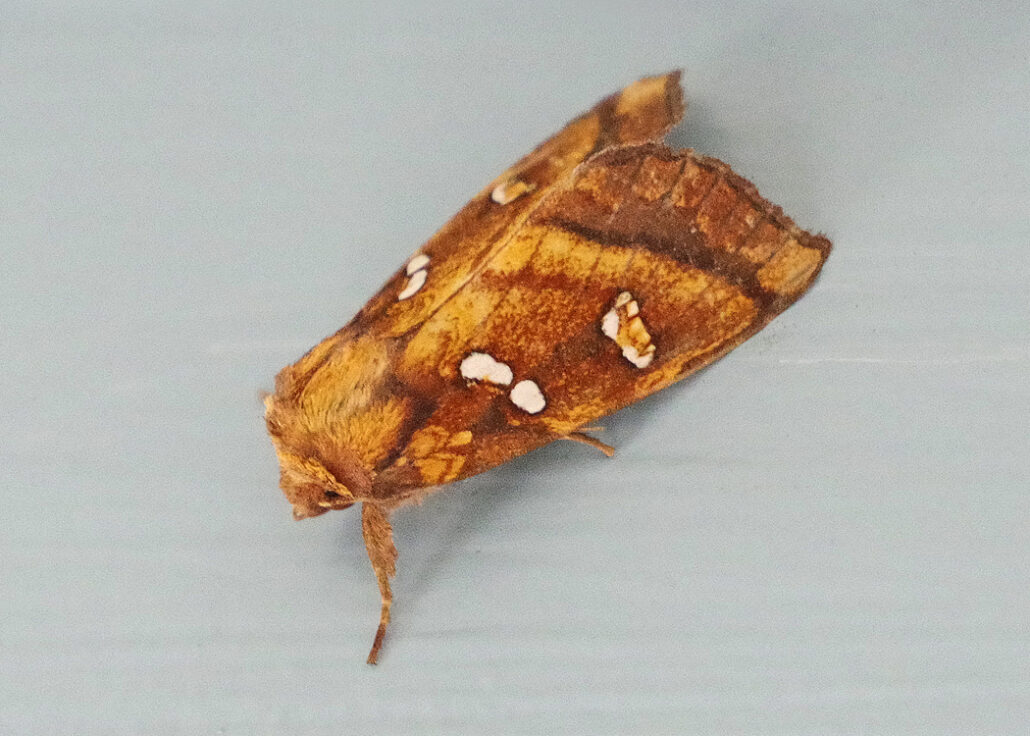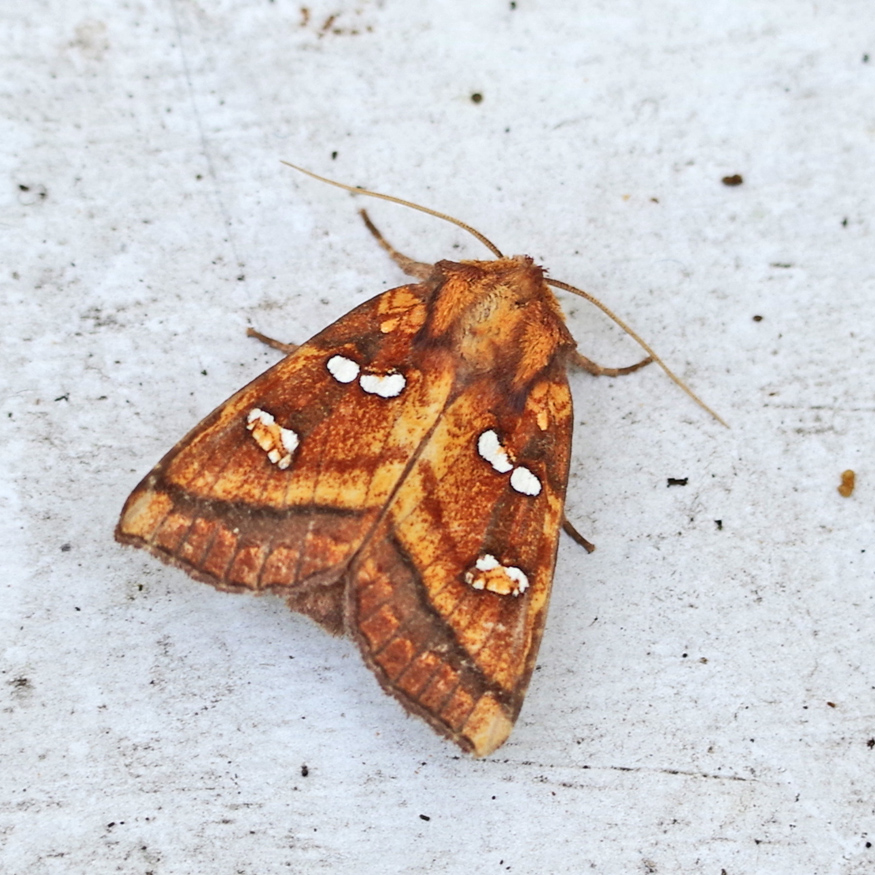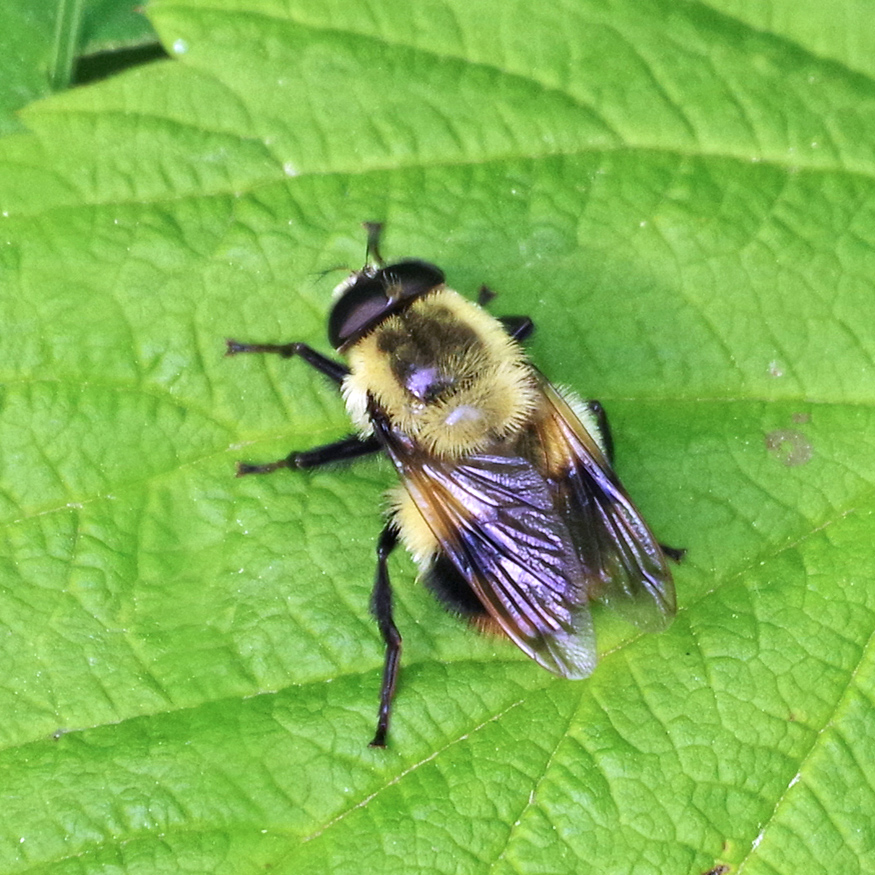by Kate Redmond
Two Enigmatic Insects
Howdy, BugFans,
In her program about insect Natural History, the BugLady says to the audience “so – we’ve been studying insects for hundreds of years – we’ve got it all nailed down, right?” Sure. The BugLady has had some interesting adventures with insects this year. Even if she can identify them (a big “if” – the X-Files are bursting), not all of them lead transparent lives (“What is it?” should, after all, not be the last question we ask about an organism, it should be the first, and the answer helps open a bunch more doors). The BugLady frequently writes about bugs who are caught in a classification dust-up. Here are two poster children for “temporarily displaced” insects.


THE BRACKEN BORER MOTH (maybe)
When the BugLady photographed this beautiful moth on her back porch rail in mid-September, she knew that it was in the genus Papaipema (the borer moths) (in the Owlet moth family Noctuidae), but which species? Caterpillars of a few Papaipema species are somewhat generalist feeders, but many are highly specific about host choice, as is evidenced by names like Blazing star borer, meadow rue borer moth, pitcher plant, burdock, iron weed, hop, and rattlesnake master borer, Joe-Pye, aster, columbine, sunflower, coneflower, turtlehead, royal fern, and cinnamon fern borer, and more (there are 50 species).
It’s a genus of moths that flies and reproduces in late summer and early fall and that are generally found near their host species. The eggs overwinter and hatch in spring, and the modus operandi of their rarely-seen caterpillars https://bugguide.net/node/view/1127727 is to bore into the roots, rhizomes, and/or stems of their (non-woody) host plants, feed in seclusion, pupate in summer, and emerge in fall. Bugguide.net remarks that “Many species are rare or locally distributed. Numbers have generally declined since historical times due to loss of wetland and prairie habitat, and the resulting scarcity of particular food plants upon which some species depend (the names of various Papaipema species appear on a number of state lists of “species in greatest need of conservation”).” Wagner, et al, in Owlet Caterpillars of Eastern North America write that “the genus seems to be speciating rapidly as evidenced by the number of species that are known to be geographically localized…. As might be expected of a large genus with specialized habits, a number of species seem to be slipping toward extinction. Close to a third of Connecticut’s 30 species have not been seen in more than three decades…”
So, who was BugLady’s visitor? It looked an awful lot like the Bracken Borer moth (Papaipema pterisii) (https://bugguide.net/node/view/1443121/bgimage), whose food plant is Bracken fern (https://illinoiswildflowers.info/grasses/plants/bracken_fern.htm). The problem was that the BugLady hasn’t seen any bracken fern in her neighborhood, but she and the moth were 20 feet away from lots of Ostrich fern. Is there an Ostrich fern borer?
She found a picture of a “potential” Ostrich fern borer https://guides.nynhp.org/ostrich-fern-borer-moth/, and the plot thickened. It hasn’t really been described or named yet (it’s one of several possibly-emerging new Papaipema species), but the DNRs and Natural Heritage Departments of a number of Northeastern states refer to it as “unnamed Papaipena species #2” or call it “Papaipema sp. 2 nr. Pterisii,” and they’re keeping an eye on it. It’s described as being larger and more richly colored than, and flying a bit later in the fall than the Bracken fern borer. It feeds on Ostrich fern (first in the stem and later in the roots), and its pupae are found in the soil at the base of Ostrich fern stalks. You can’t tell the difference between it and the Bracken borer in a photograph.
But what is its status in Wisconsin, the BugLady wondered? She asked PJ, and PJ asked Les, and Les recommended sticking with Bracken borer for now – it’s not known if the Bracken borer might be using more than one host, and identifications shouldn’t be made just on the basis of host plants. It is likely not a valid species, said Les, but a publication due out in early 2025 may shed more light on it. Thanks, Gentlemen. Stay tuned.

YELLOW-FACED SWIFTWING – Version 1
How do you tell a fly from a bee? Easy – hymenopterans (bees, wasps, etc.) have four wings and flies have two. Except that, hymenopterans typically perch with their wings more-or-less stacked, and very few are cooperative enough to spread their wings so that we can count them. The BugLady recognized this bumble bee mimic as a fly because of its (wimpy) antennae and because of the large, flattened eyes https://bugguide.net/node/view/1838687/bgimage. One entomologist calls them “wanna bees.” Here’s a bumble bee for comparison https://bugguide.net/node/view/1221268/bgimage.
It’s a syrphid/hover/flower fly (family Syrphidae) in the genus Volucella (the Swiftwings), a genus that according to most internet sources has four species in North America. Probably a Yellow-faced Swiftwing (Volucella facialis) (if it’s not, it’s an Eastern Swiftwing (V. evecta). Members of the genus look a little “hippy” (no judgement) (“broad-bodied,” says one source), have triangular faces, and their “arista” (the bristle that juts off of the antenna) is plumose (feathery) https://bugguide.net/node/view/1870769/bgimage. Here’s a glamour shot https://bugguide.net/node/view/1494989/bgimage.
YELLOW-FACED SWIFTWING – Version 2
So, the BugLady had settled on the narrative above, but then she found an article from the University of California, written in 2020, that pretty much upended it. According to entomologist Andrew Young, there is only one species of Volucella fly in North America, and it’s Volucella bombylans, whose range stretches across Eurasia (it’s called the Bumblebee hover fly in England), the Near East, and North America. There was no suggestion of whether it had or had not immigrated here from someplace else. All the “other” Volucellas in this country, says Young, are simply varieties of V. bombylans, and they probably exist as a “species complex,” a group of closely-related species that look so much alike that we can’t differentiate among them and that may be able to hybridize. Hold your horses, say other biologists, there are no species complexes, it’s just that our meager observational skills don’t yet allow us to detect their differences. Scott King, in his The Flower Flies of Minnesota (2021), writes that “the Volucella bombylans species complex was only recently unraveled into three Nearctic [New World] species, two of which [V. facialis and V.evecta] live in Minnesota.”
Whatever the name, the life histories of these flies is similar – they lay their eggs in the nests of social wasps and especially of bumble bees (whose nests they have no trouble entering). When the eggs hatch, the fly larvae are detritivores, feeding on organic debris in the nest, including dead bees, and on bee larvae, too, and some eat bee and wasp pupae within the nest. They are inquilines – animals that live in another animal’s space (from the Latin word “inquilinus,” meaning tenant or lodger). Some inquilines don’t eat their hosts, but some do. The esteemed French naturalist and entomologist Henri Fabre (1823 to 1915) wondered how the larvae could survive inside a wasp nest: “What has it to make itself thus respected? Strength? Certainly not. It is a harmless creature which the Wasp could rip open with a blow of her shears, while a touch of the sting would mean lightening death.”
Adult Volucella are nectar feeders that, says Wikipedia, like to sun themselves on leaves, and it also says that the genus is strongly migratory and that males are often territorial. Syrphids are important pollinators.
Kate Redmond, The BugLady
Bug of the Week archives:
http://uwm.edu/field-station/category/bug-of-the-week/
